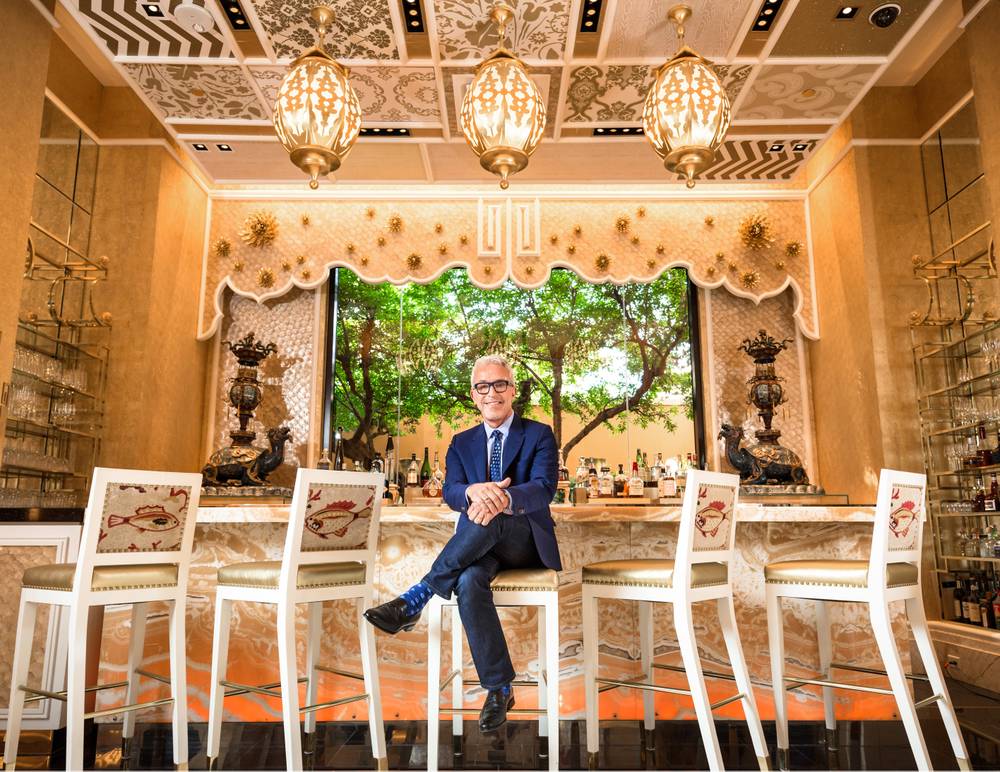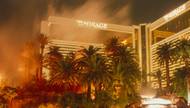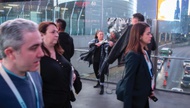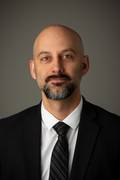Las Vegas exists mainly in our minds. In the actual world, it’s an improbable city in the desert. In your head, it doesn’t have to make sense. That’s not why you came or why you came back. The Vegas of your memories is the real Vegas, the fantastical escape, sensational and malleable.
The Vegas of my mind isn’t a place as much as a feeling. It feels like celebration plus relaxation with a big dose of irrational extravagance. It feels like I have no business doing what I’m doing and that’s why it’s so great. It occurs when I walk into favorite hotels, the icons of the Strip, and get hit with both the obvious (erupting volcanoes, sky-high dancing fountains, gigantic stained-glass flowers) and the more subtly striking (lobby aquariums, natural light, tropical gardens, endlessly rich fabrics and finishes). Lately, it happens mostly when I’m at Wynn, because it’s simply the best place to be, somehow more stunning and sumptuous now that it’s 10 years old.
As a disconnected kid growing up in this actual world, I could only wonder what treasures were hidden inside these temples, peering through the car window during the rare drive down the Strip or flipping through the Showbiz magazine that came with the Friday paper, hunting for clues about casinos, lounges, restaurants and other beautiful things that lived within. Now they’re at my disposal every day. I visit them every week, and I still maintain the childlike wonder I know Vegas visitors feel when they first arrive. It’s all about that moment, how it looks and pulls and excites, and isn’t it crazy that it’s someone’s job to create these feelings and experiences? Someone sculpted this wow.
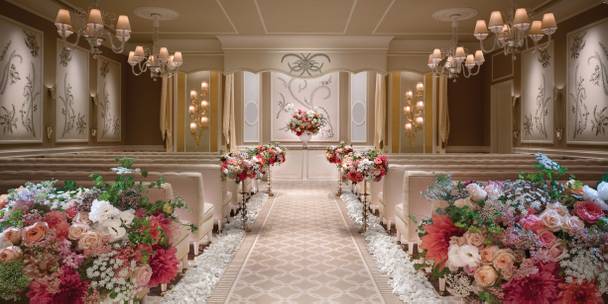
The Wedding Salons at Wynn
I say these things to Roger Thomas when we speak for the first time. If there’s one person most responsible for building the Vegas of my mind, he is that man. “Well, I’m flattered,” he says, “but I didn’t do it by myself.”
Thomas is head of design for Wynn Resorts. Working closely with Steve Wynn, he’s responsible not only for the acclaimed vision of the Wynn and Encore hotels, but also for the two Strip resorts that changed Las Vegas more than any others—the Mirage and Bellagio. Thomas received the Designer of the Year award at the International Hotel Show in 2008 and the Jay Sarno Lifetime Achievement Award in Casino Design the following year. He’s been inducted into the UNLV Hall of Fame, and Architectural Digest has named him to the AD100 four times. The hotel rooms at Wynn were the first in the history of Las Vegas to receive the Forbes five-star designation.
The question is not about the impact Thomas has made here and throughout the casino and hotel industry, or how he has influenced the Vegas experience. Every casino shows some hint of aspirational—if not outright—luxury, or demonstrates the attention to decorative little details that make a big difference. Those are the master’s hallmarks. No, the question is: How does he do it?
“The main objective is to create a place that is unique,” he says. “We have to invent not only the vocabulary and the idea of a place but also the customs and all the parts and pieces. Otherwise you’ll say, ‘Look, Harry, that’s the same chandelier as the place in blank,’ or, ‘I remember that chair, it was in blank.’ I don’t ever want to hear that.”
It’s not as simple as finding special parts and creating lovely pieces. They must come together. “What we’re supposed to be doing is creating memories, spaces that are possibly romantic and mysterious and surprising, and very, very comfortable. It has to be intriguing, with some humor in it, and layered with details that you’ll want to investigate time after time. If you do that, then the guest will say, ‘I’ve never felt like this anywhere else,’ and they have to come back. That’s a big part of my job.”
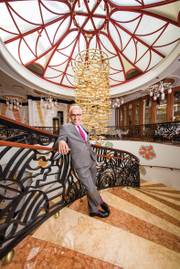
Thomas inside Bartolotta
In a 2012 profile in The New Yorker—which detailed how Thomas and Wynn defied all traditional casino design standards with the Mirage, possibly the first Las Vegas resort that sought to liberate its patrons rather than ensnare them—Wynn is famously quoted saying, “Trying to separate Roger from whatever credit I’ve received in my lifetime is ridiculous ... Roger’s taste level and his creativity are 60 percent of the success we’ve had.” Thomas gracefully returns the praise today. “Everything I do, I do very much interlocked with Steve. Everything I’ve accomplished is because of the patronage of his vision.”
Their partnership is one of family. Born in Salt Lake City in 1951, Thomas grew up in Las Vegas from the age of 3. His father is E. Parry Thomas, the banker, visionary and true architect of Las Vegas. With his business partner Jerry Mack, Parry Thomas financed and developed the casinos that formed the Strip and drew visitors from everywhere; put together the real estate deals and personally guaranteed the loans that grew UNLV into a proper university; engineered Howard Hughes’ arrival and the subsequent buyout of the mob in Las Vegas; and mentored a young Steve Wynn, whom he considers his fifth son.
Roger Thomas was 13 when he met Wynn and quickly came to see him as an older brother. “I would listen to him say how we weren’t fooling anybody with the way Las Vegas looks,” Thomas says. “Fake marble doesn’t fool anybody. He’d say we needed to get the right guys in the hotels to have really good design, that you can’t create a theatrical veneer, you have to have substance and quality. I’d listen to all this with my father and knew he was absolutely right. That’s the Las Vegas I wanted to see.” Thirty-seven years ago, they went to work together to build it.
Thomas’ first gig with Wynn was redesigning six penthouse suites at the Golden Nugget. They were all different, from the one inspired by a Victorian garden room to the one inspired by the exotic Orient to the one built around everything Thomas loved about French interiors of the 18th century. The most valued guests stayed in these apartment-style accommodations, and each VIP developed an affinity for his own suite and wanted to stay in the same one again and again. It became a problem if that suite was unavailable. “I learned that one really great accommodation is better than a selection,” Thomas says. “There is a school of thought that luxury means as many as you want, and I disagree completely. It’s real taste and ability and thought and comfort that make your experience wonderful, and we’ve made those decisions for you, and they’re all the right decisions.”
The most expensive hotel-casino ever built when it opened in 1989, the 3,000-room, Polynesian-themed Mirage famously blew away everything else that came before it. The welcoming lobby and casino spaces were grand and luxurious, but also open and airy in an unprecedented way. “Steve reasoned no one goes to dark places on vacation,” Thomas says, so they let the light in with a rainforest-themed atrium at the property’s entrance.
When they made plans to outdo themselves with Bellagio, which opened in 1998, Wynn again directed Thomas to concentrate on creating the most extraordinary hotel on the planet, the most dramatic and elegant. Thomas traveled the world collecting his pieces, “going places I’ve never been to figure out how to manufacture Venetian chandeliers and things that have never happened in Las Vegas.”
Dave Duggan—who came to Las Vegas to open Treasure Island before moving to Bellagio, and now works in construction and operations for Downtown Project—knows the difference between Wynn properties and everything else. As assistant director of engineering, it was his job to maintain the Bellagio’s beauty, often working with Thomas. “I think people go to those properties and realize it’s Roger Thomas and it’s on a different level,” Duggan says. “His boundaries are a lot broader. Now, a lot of that stuff gets value-engineered or taken out of the equation. That wasn’t the case back then.”
Bellagio was astounding, a level of opulence that set an unapproachable standard ... until Wynn asked Thomas to do it again. “When Steve said the Wynn had to be the most amazing hotel on planet Earth, I told him, ‘If I knew you were going to ask that again, I wouldn’t have tried so hard the first time!’ But he was right. It’s fun to outdo ourselves.”
The next time I talk to Roger Thomas, inside the gleaming gold and emerald green Wing Lei restaurant, he clarifies that concept. “I don’t think of actually outdoing myself. Anybody in a creative field learns from what they’ve just done, and in the process of doing a project, ideas seem to percolate and come forward. I don’t know anybody who says, ‘I think I’ll do this at the same level as the last one.’ Everyone sees the opportunity to improve on the last creation.”
While creating Bellagio, Thomas spent a lot of time in London, Paris, Venice, Florence, Rome, New York and LA, and he stayed in many different hotels. So when preparing designs for the Wynn resort, he felt well-informed of the competition, the varying environments and levels of service. A hotel designer also designs opportunities for service, from equipping the concierge with the right desk to establishing mise en place in a restaurant to guarantee the transfer to tabletop is elegant and not clunky and uncomfortable, which everyone would notice. “All of those things are as important to me as the color of the walls or the texture of the coverings or the patterning of the carpet,” he says. “They’re all parts of the environment.”
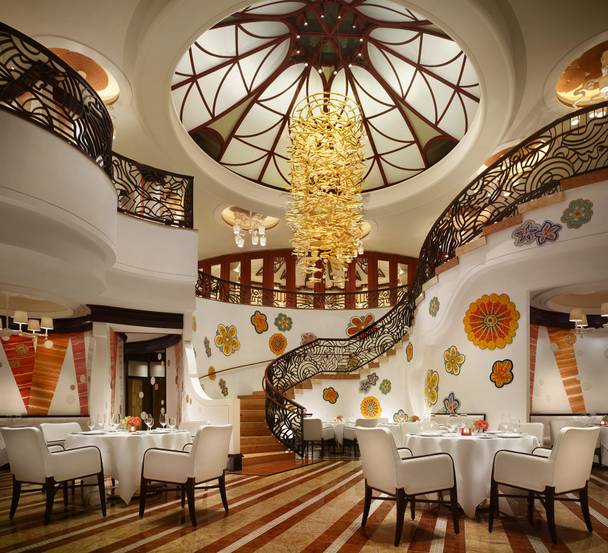
You probably won’t notice those elements at Wynn, and you’re not supposed to. But that’s also because you’re drawn to moments of charm like the lush, sparkling garden walkway, the crisp, bright check-in area and the whimsical Parasol Down bar that opens onto the Lake of Dreams.
The resort’s restaurants, always considered a culinary pinnacle on the Strip, were essential design destinations from the start, and several have been renovated recently. “When we’re lucky enough to have someone in a room with us for a while, we want them to be thoroughly engaged,” Thomas says. “I often talk about rooms of possibility. In a restaurant, I want you to feel like your most romantic self. I want the light to be so good that I never looked better than when I sat in this room.” This partially explains Wing Lei’s goldness—it’s one of the best colors of light reflection for human complexion. “If you bounce the light off gold onto your skin, we all look great.”
Restaurateur Elizabeth Blau, who curated the dining lineups at Bellagio and Wynn before opening her own acclaimed restaurants in recent years, calls Thomas an inspiration and a mentor. “The magic of a restaurant starts with the design,” she says. “All the [ideas] for my own places started with working with Roger and Steve. The spaces [at Wynn] are just timeless. How can you ever tire of going to SW or Mizumi or Bartolotta? You don’t feel like you’re in Vegas.”
The Wynn standard is just as evident in spaces people are meant to move through. In designing the retail promenade—the one lined with shops from Alexander McQueen, Chanel, Dior, Louis Vuitton and Manolo Blahnik—Thomas honed in on creating an interesting journey “punctuated with rhythm and cadence. I don’t want it to seem like a long route.”
And though it’s still one of the Strip’s premier destinations for gaming, the Wynn casino functions as a relaxing thoroughfare. How do you turn a bustling, 111,000-square-foot casino into something calm and comfortable? One of Thomas’ tricks was giving each blackjack table its own chandelier. “It was hard to do because gaming regulators insist on an extraordinary overview of security cameras,” he says. “But when we built a full-scale functioning model of our casino, we developed chandeliers with cameras in them so we could prove to the board they’d have everything they wanted. We’re the only ones who have done that.”
Thomas is a perpetual student influenced by the classics, but he forgoes emulation to use what he’s learned to inspire his own designs. Occasionally he’ll contradict those classics and see how far he can push things in an effort to find a new language and new forms. He’s forever drawing in sketchbooks, whether waiting to catch an airplane or sitting in meetings. He swims every weekend, for meditation as much as for exercise, and often leaps out of the pool to sketch an idea born between laps.
With a game-changing body of work in Thomas’ wake, next on the docket are the finishing touches for Wynn Palace on the Cotai Strip in Macau, a multi-billion-dollar resort scheduled to open next year. Then, it’ll be the Wynn Everett resort in Massachusetts, a circular occurrence for Thomas, who was educated at Tufts University and the School of the Museum of Fine Arts in Boston. “There was a while in college where I was sure I would never leave the East Coast, never go back to Las Vegas again. But opportunities and exciting projects brought me back. I say I’ve been leaving Las Vegas since then, I just haven’t made it out of town yet. ... The minute the projects are not exciting, I’m out of here.”
That’s one of the last things Roger Thomas says to me. And it’s a disheartening thought, because without his vision, my Las Vegas wouldn’t exist. But it does. It’s real. I can feel it.
